Groundwater Vulnerability Assessment of the Pingtung Plain in Southern Taiwan
Abstract
:1. Introduction
2. Materials and Methods
2.1. Study Area
2.2. DRASTIC Model
2.3. Discriminant Analysis
2.4. Data Preparation
3. Results and Discussion
3.1. Ratings of Parameters and Vulnerability Index Obtained Using the Conventional DRASTIC Model
3.2. Improved DRASTIC Model Using Discriminant Analysis
3.3. Sensitivity of the Factors Used in DRASTIC
4. Conclusions
Acknowledgments
Author Contributions
Conflicts of Interest
References
- Spalding, R.F.; Exner, M.E. Occurrence of Nitrate in Groundwater—A Review. J. Environ. Qual. 1996, 22, 392–402. [Google Scholar] [CrossRef]
- Ward, M.H.; deKok, T.M.; Levallois, P.; Brender, J.; Gulis, G.; Nolan, B.T.; VanDerslice, J.; International Society for Environmental Epidemiology. Workgroup report: Drinking-water nitrate and health—Recent findings and research needs. Environ. Health Perspect. 2005, 113, 1607–1614. [Google Scholar] [CrossRef] [PubMed]
- Weyer, P.J.; Cerhan, J.R.; Kross, B.C.; Hallberg, G.R.; Kantamneni, J.; Breuer, G.; Jones, M.P.; Zheng, W.; Lynch, C.F. Municipal drinking water nitrate level and cancer risk in older women: The Iowa Women’s Health Study. Epidemiology 2001, 12, 327–338. [Google Scholar] [CrossRef] [PubMed]
- National Research Council. Ground Water Vulnerability Assessment: Predictive Relative Contamination Potential under Conditions of Uncertainty; National Academy Press: Washington, DC, USA, 1993; pp. 42–63. [Google Scholar]
- Barbash, J.E.; Resek, E.A. Pesticides in Ground Water: Distribution, Trends, and Governing Factors, 1st ed.; CRC Press: Chelsea, MI, USA, 1997; p. 616. [Google Scholar]
- U.S. Environmental Protection Agency (EPA). DRASTIC: A Standardized System for Evaluating Groundwater Potential Using Hydrogeological Settings; Oklahoma WA/EPA Series; U.S. Environmental Protection Agency (EPA): Ada, OK, USA, 1985; p. 163.
- Aller, L.; Bennett, T.; Lehr, J.H.; Petty, R.J.; Hackett, G. DRASTIC: A Standardized System for Evaluating Ground Water Pollution Potential Using Hydrogeologic Settings; EPA: Washington, DC, USA, 1987.
- Babiker, I.S.; Mohamed, A.A.M.; Terao, H.; Kato, K. A GIS-based DRASTIC model for assessing aquifer vulnerability in Kakamigahara Heights, Gifu Prefecture, central Japan. Sci. Total Environ. 2005, 345, 127–140. [Google Scholar] [CrossRef] [PubMed]
- Baalousha, H. Vulnerability assessment for the Gaza Strip, Palestine using DRASTIC. Environ. Geol. 2006, 50, 405–414. [Google Scholar] [CrossRef]
- Assaf, H.; Saadeh, M. Geostatistical assessment of groundwater nitrate contamination with reflection on DRASTIC vulnerability assessment: The case of the upper Litani basin, Lebanon. Water Resour. Manag. 2009, 23, 775–796. [Google Scholar] [CrossRef]
- Panagopoulos, G.; Antonakos, A.K.; Lambbrakis, N.J. Optimization of the DRASTIC method for groundwater vulnerability assessment via the use of simple statistical methods and GIS. Hydrogeol. J. 2006, 14, 894–911. [Google Scholar] [CrossRef]
- Antonakos, A.K.; Lambrakis, N.J. Development and testing of three hybrid methods for the assessment of aquifer vulnerability to nitrates, based on the drastic model, an example from NE Korinthia, Greece. J. Hydrol. 2007, 333, 288–304. [Google Scholar] [CrossRef]
- Saidi, S.; Bouri, S.; Ben, D.H.; Anselme, B. Assessment of groundwater risk using intrinsic vulnerability and hazard mapping: Application to Souassi aquifer, Tunnisian Sahel. Agric. Water Manag. 2001, 98, 1671–1682. [Google Scholar] [CrossRef]
- Huan, H.; Wang, J.; Teng, Y. Assessment and validation of groundwater vulnerability to nitrate based on a modified DRASTIC model: A case study in Jilin City of northeast China. Sci. Total Environ. 2012, 440, 14–23. [Google Scholar] [CrossRef] [PubMed]
- Jang, C.S.; Lin, C.W.; Liang, C.P.; Chen, J.S. Developing a reliable model for aquifer vulnerability. Stoch. Environ. Res. Risk Assess. 2016, 30, 175–183. [Google Scholar] [CrossRef]
- Agriculture Engineering Research Center. Survey, Analysis and Assessment of Groundwater Quality in Taiwan Areas in 2009; Water Resources Agency, Ministry of Economic Affairs, Executive Yuan: Taipei, Taiwan, 2009.
- Taiwan Central Geological Survey (CGS). Hydrogeological Survey Report of Pingtung Plain, Taiwan. Central Geological Survey; Ministry of Economic Affairs, Executive Yuan: Taipei, Taiwan, 2002; pp. 97–142.
- Liu, C.W.; Wang, S.W.; Jang, C.S.; Lin, K.H. Occurrence of arsenic in groundwater of the Choshui river alluvial fan, Taiwan. J. Environ. Qual. 2006, 35, 68–75. [Google Scholar] [CrossRef] [PubMed]
- Ting, C.S.; Zhou, Y.; de Vries, J.J.; Simmers, I. Development of a preliminary ground water flow model for water resources management in the Pingtung Plain, Taiwan. Ground Water 1998, 35, 20–36. [Google Scholar] [CrossRef]
- Sharma, S. Applied Multivariate Technique; Wiley: New York, NY, USA, 1996. [Google Scholar]
- Chow, V.T.; Maidment, D.; Mays, L.W. Applied Hydrology; McGraw Hill: New York, NY, USA, 1988; p. 498. [Google Scholar]
- Taiwan Central Geological Survey (CGS). Project of Groundwater Monitoring Network in Taiwan during First Stage: Research Report of Choushui River Alluvial Fan; Water Resources Bureau: Taipei, Taiwan, 1999; p. 383.
- Journel, A.G.; Huijbregts, C.J. Mining Geostatistics; Academic Press: San Diego, CA, USA, 1979. [Google Scholar]
- Stigter, T.; Almeida, P.; Carvalho, D.A.; Ribeiro, L. Evaluation of an intrinsic and specific vulnerability assessment method in comparison on a regional scale. Hydrogeol. J. 2006, 14, 79–99. [Google Scholar] [CrossRef]
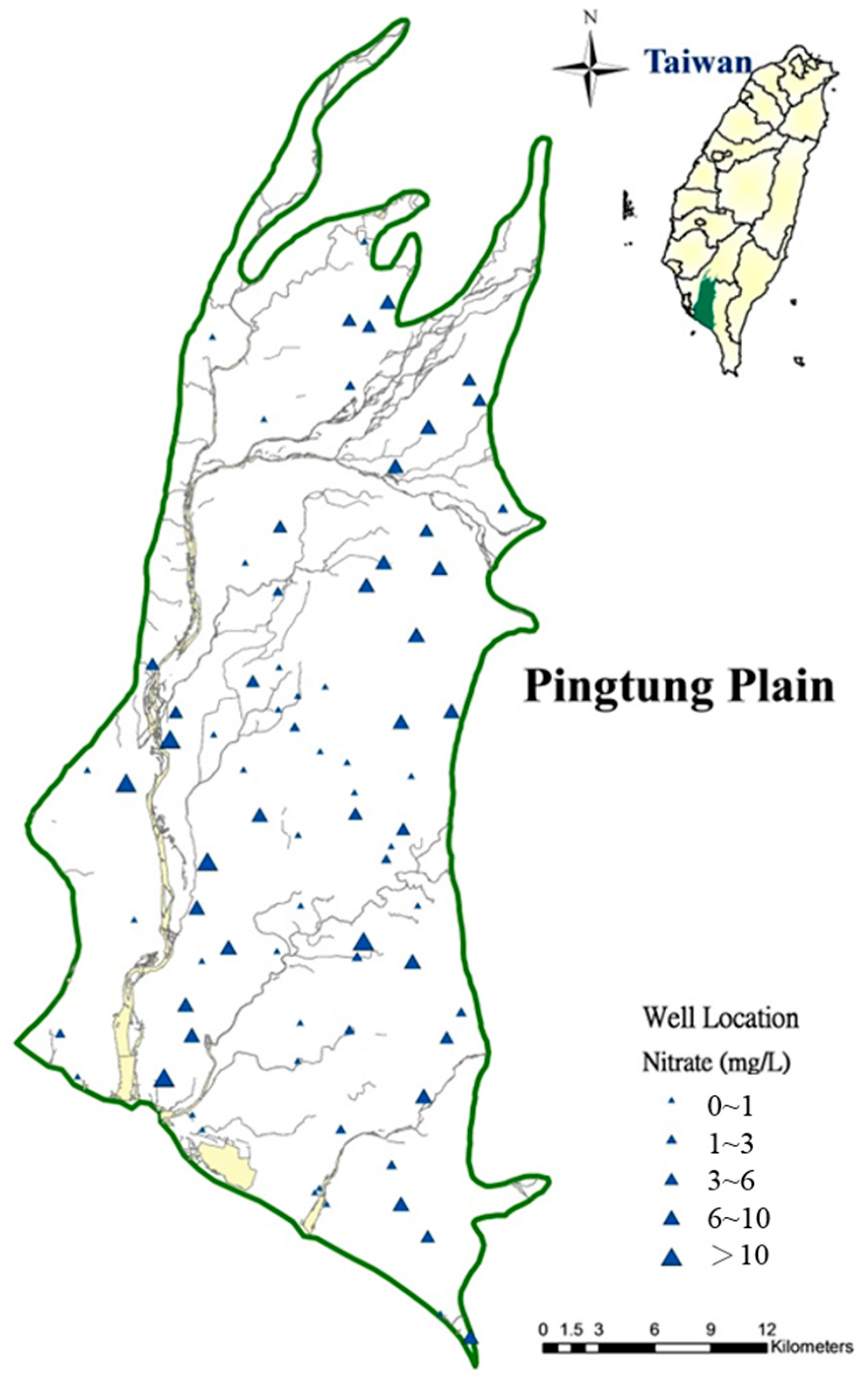
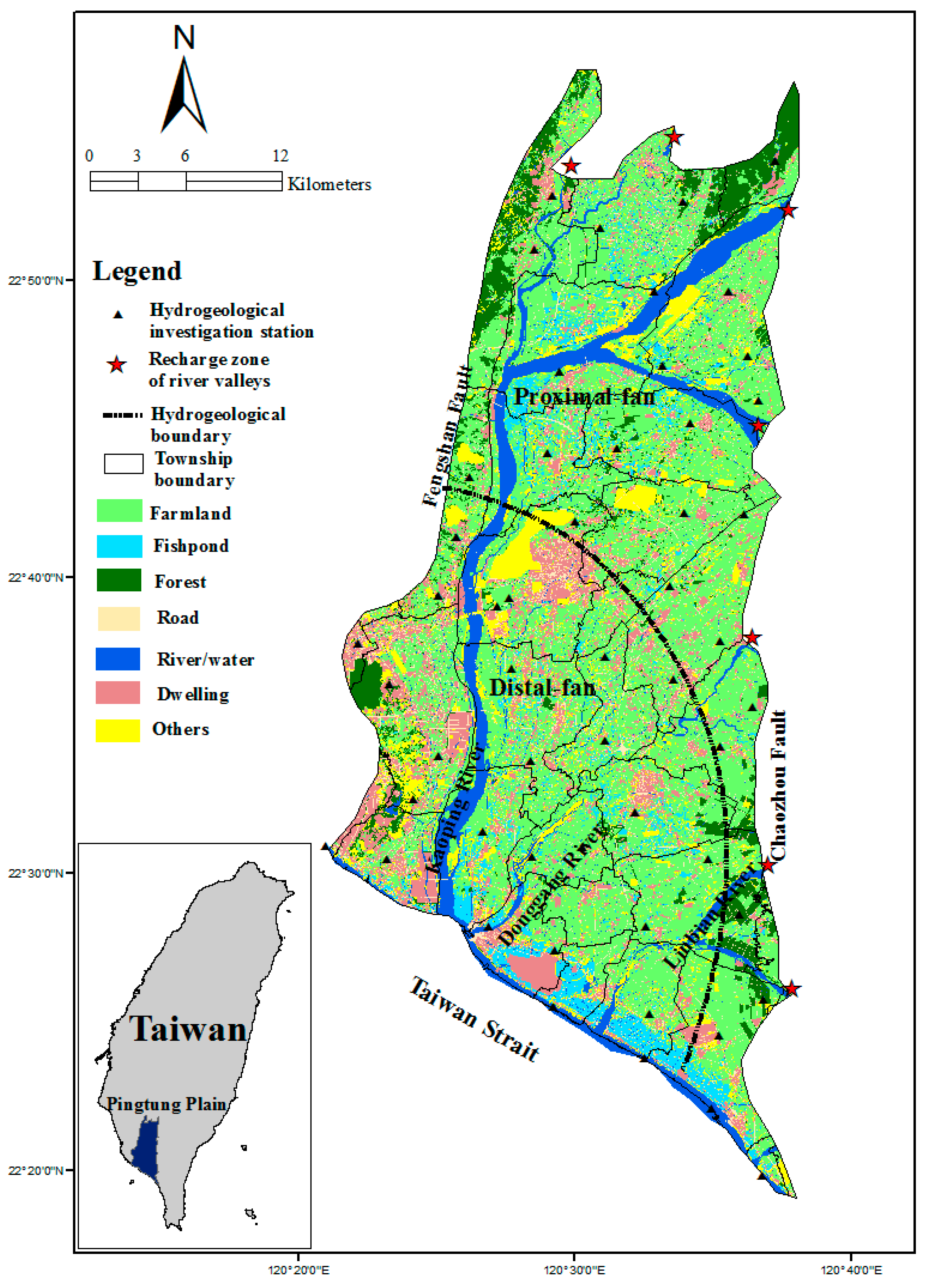
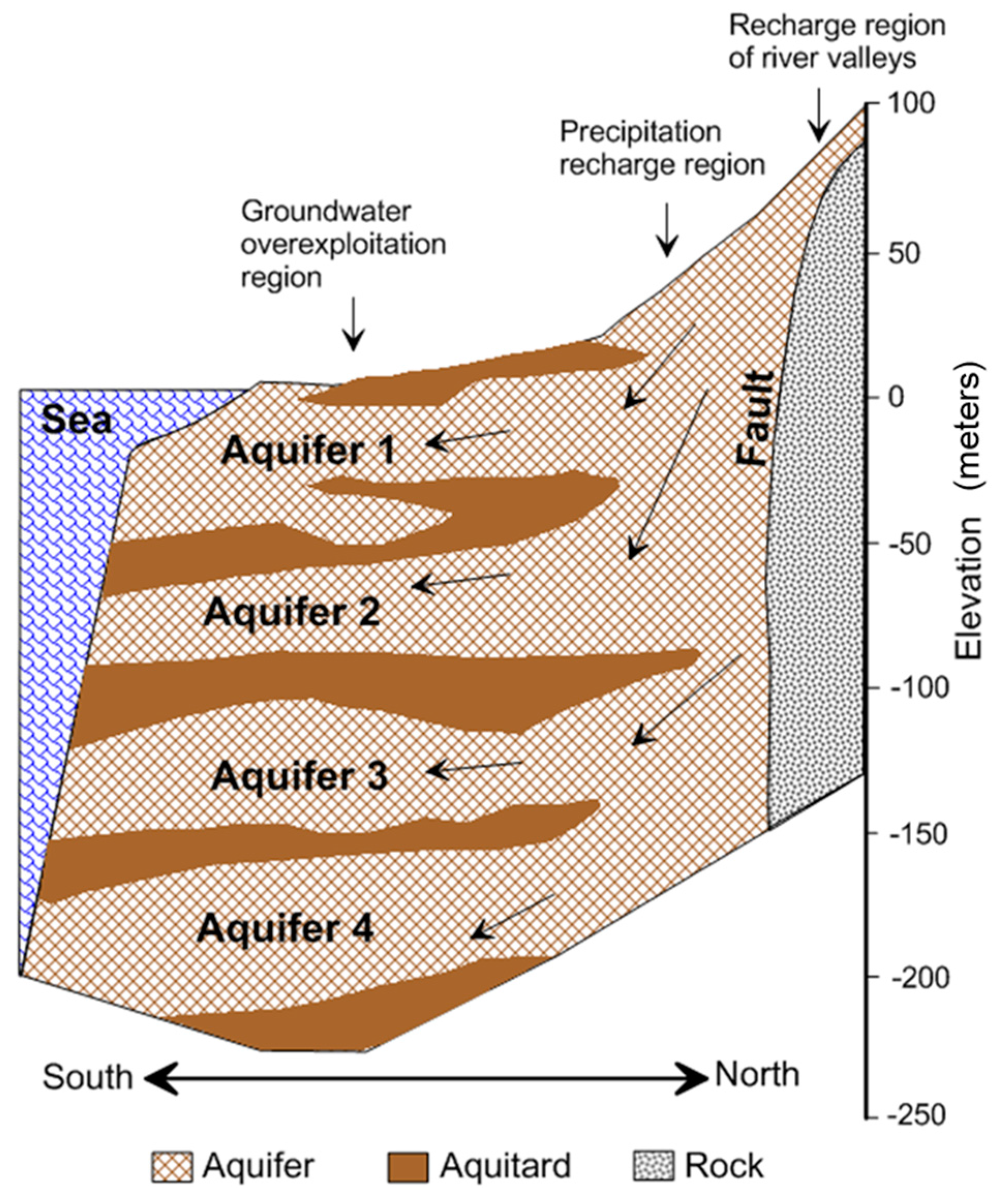
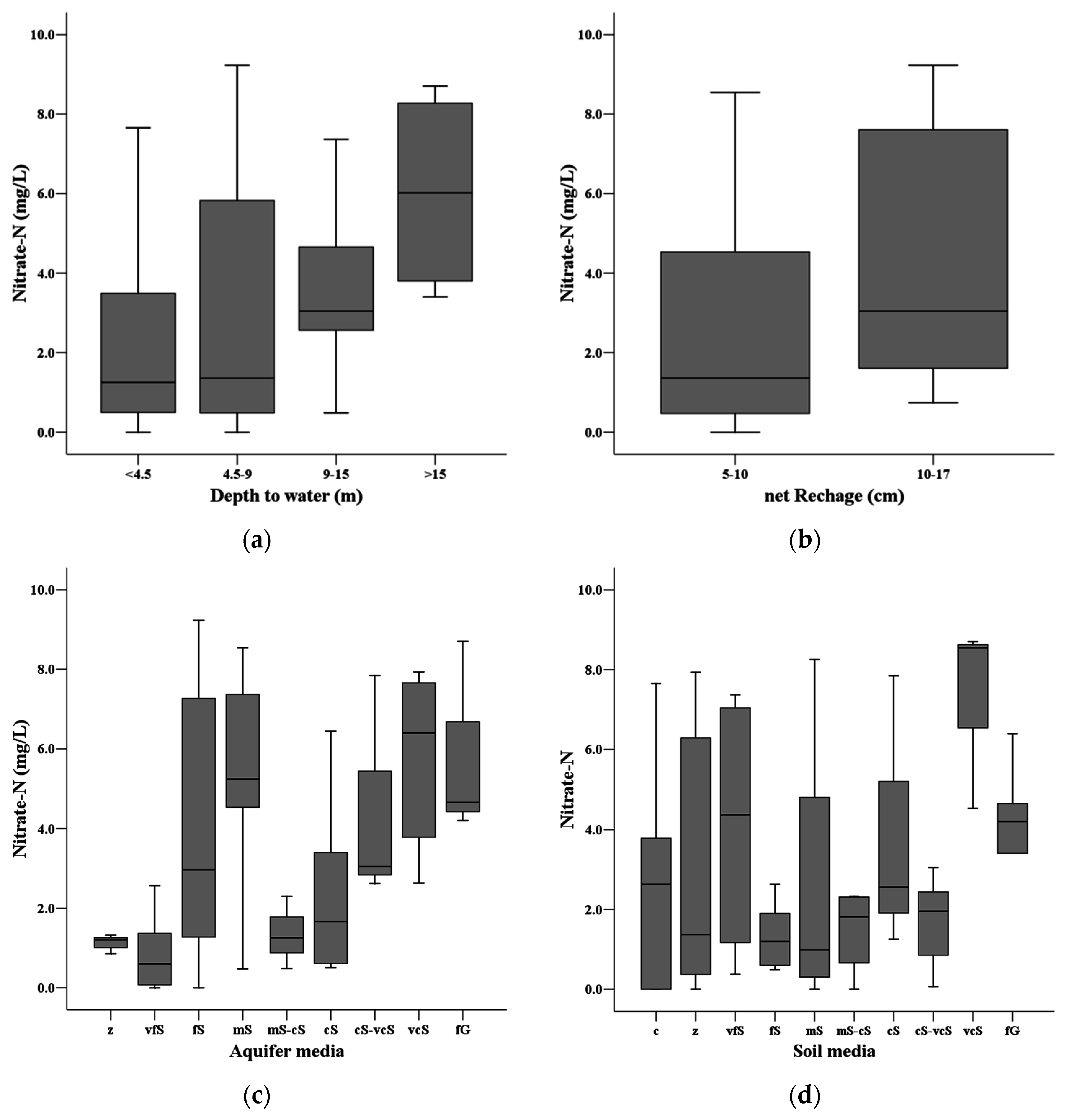
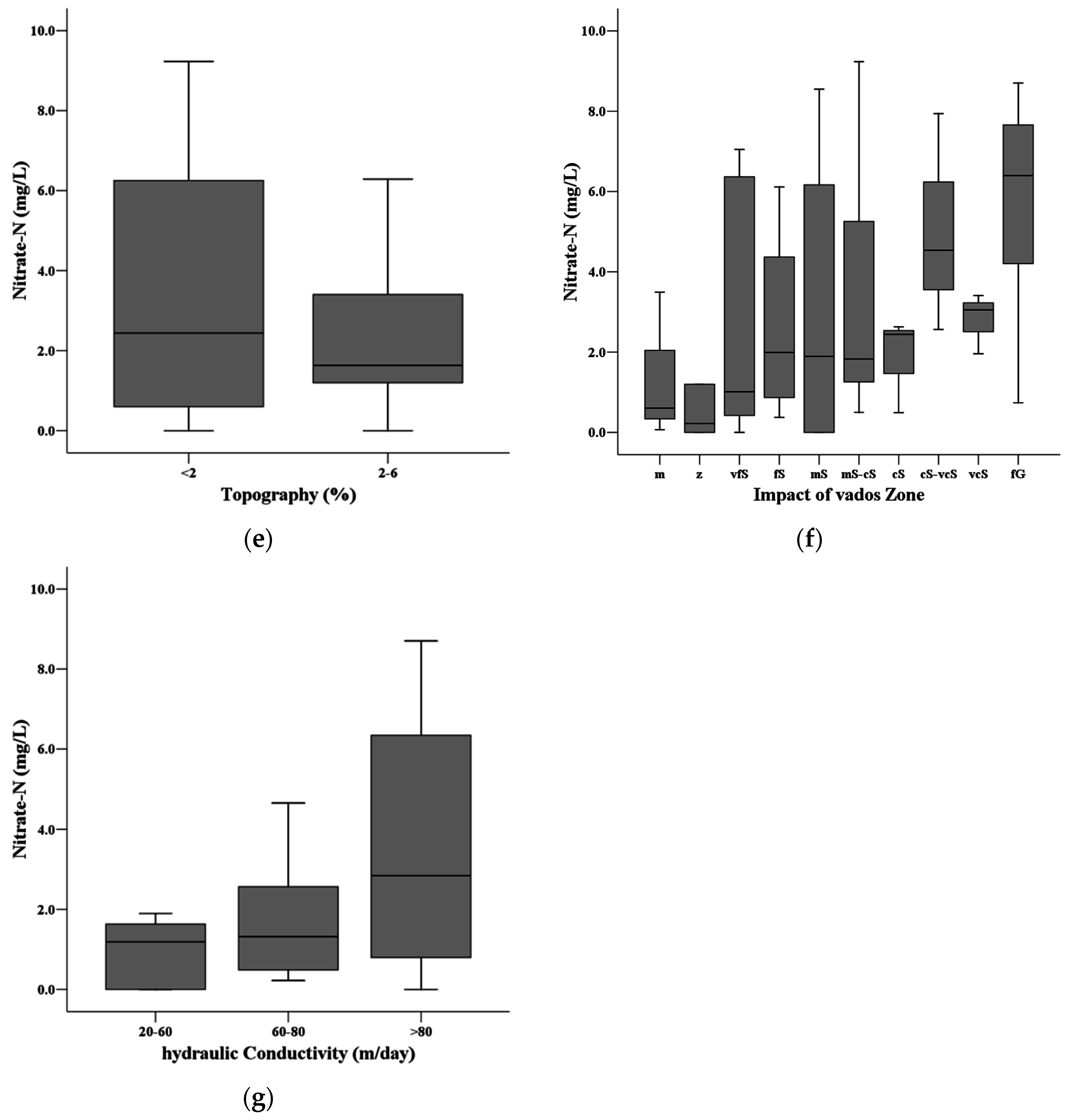
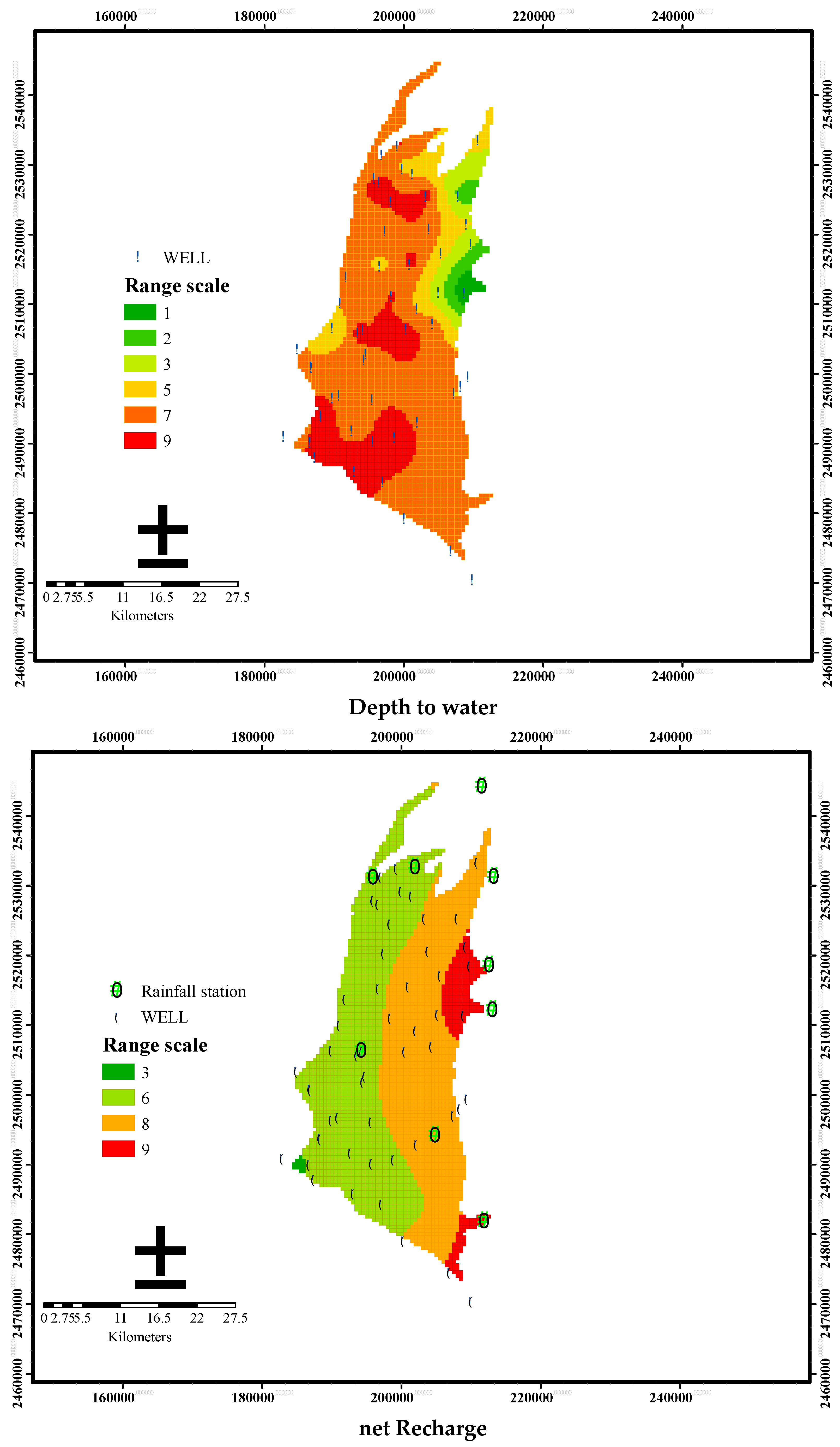
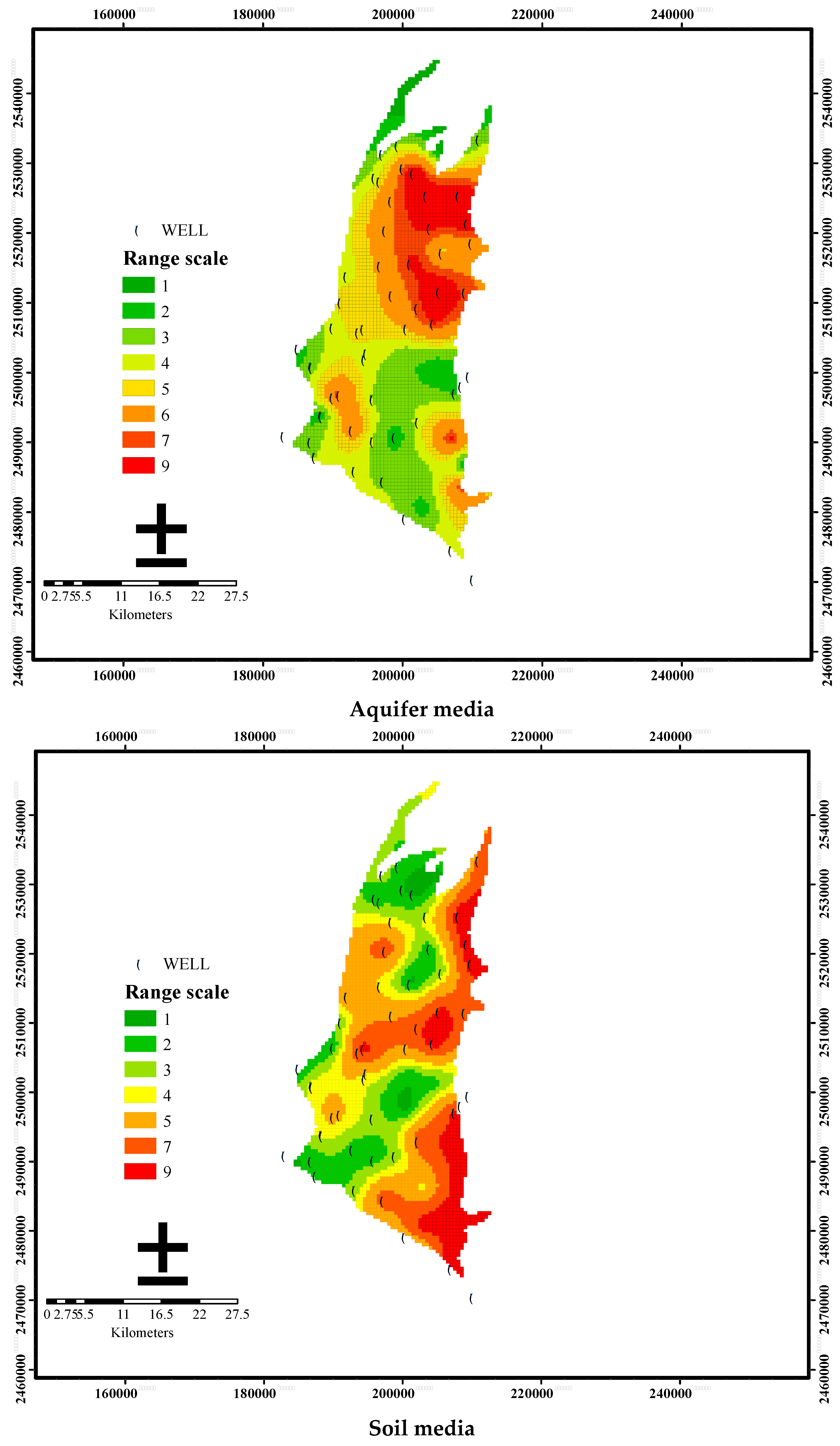
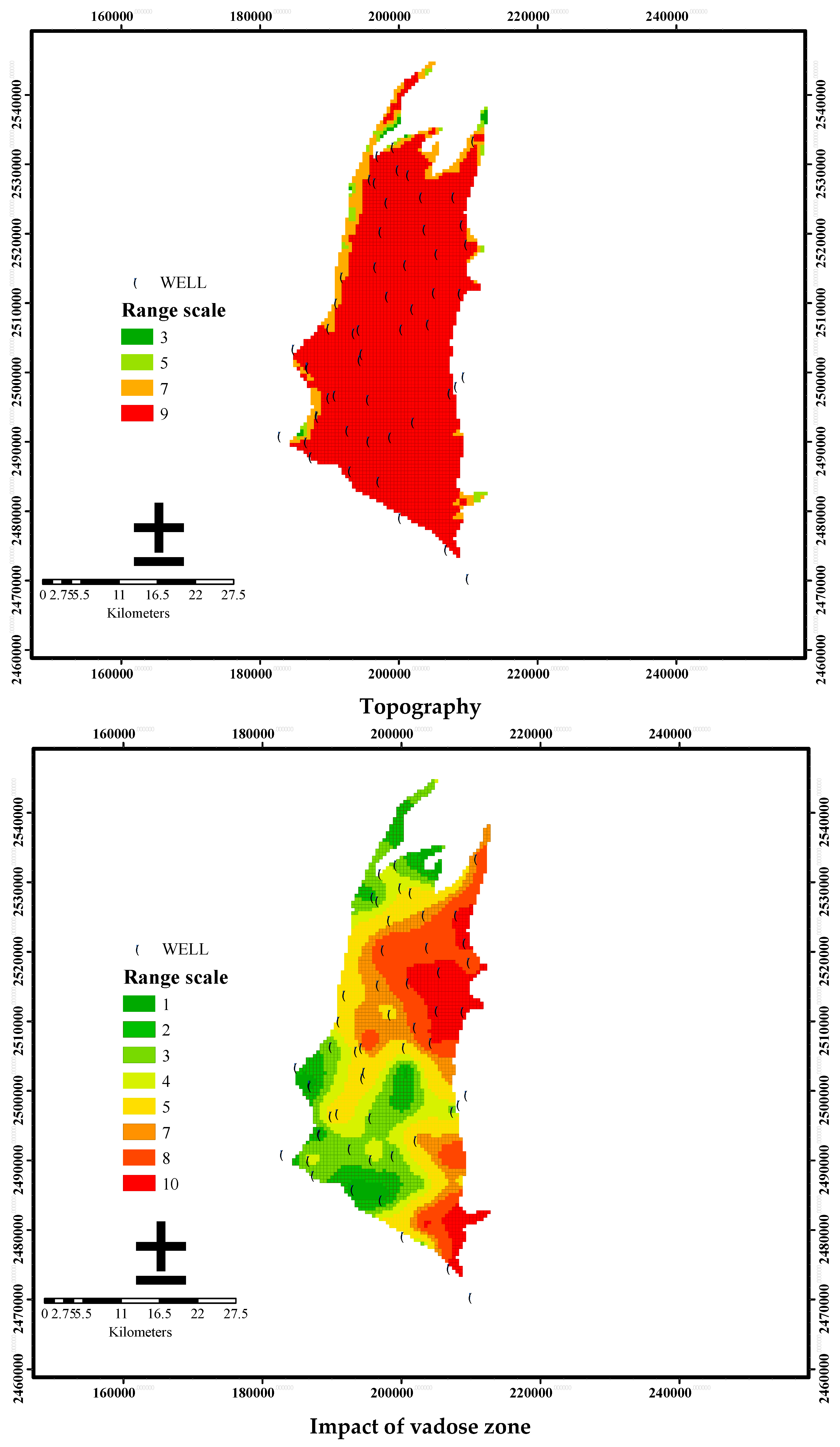
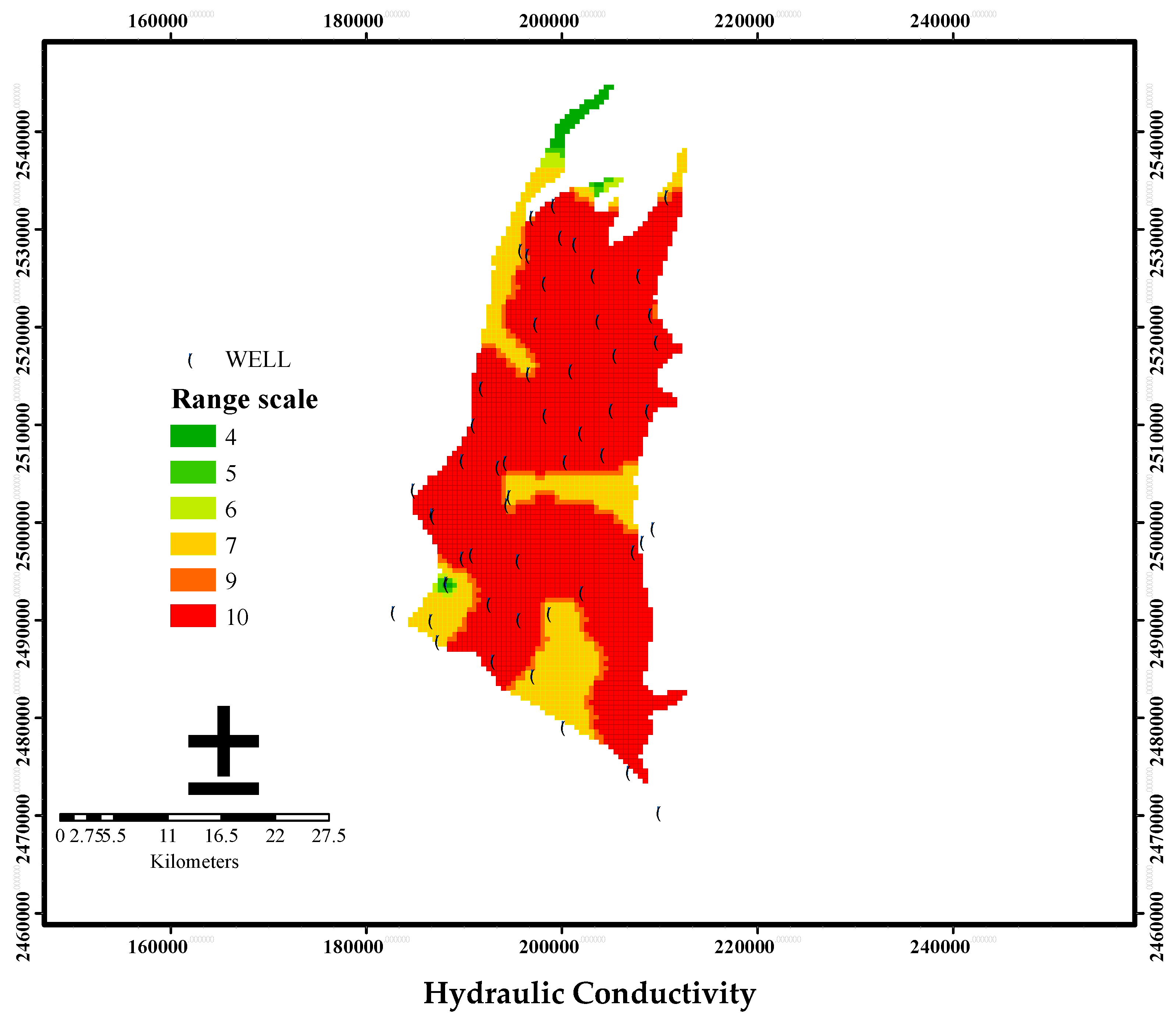
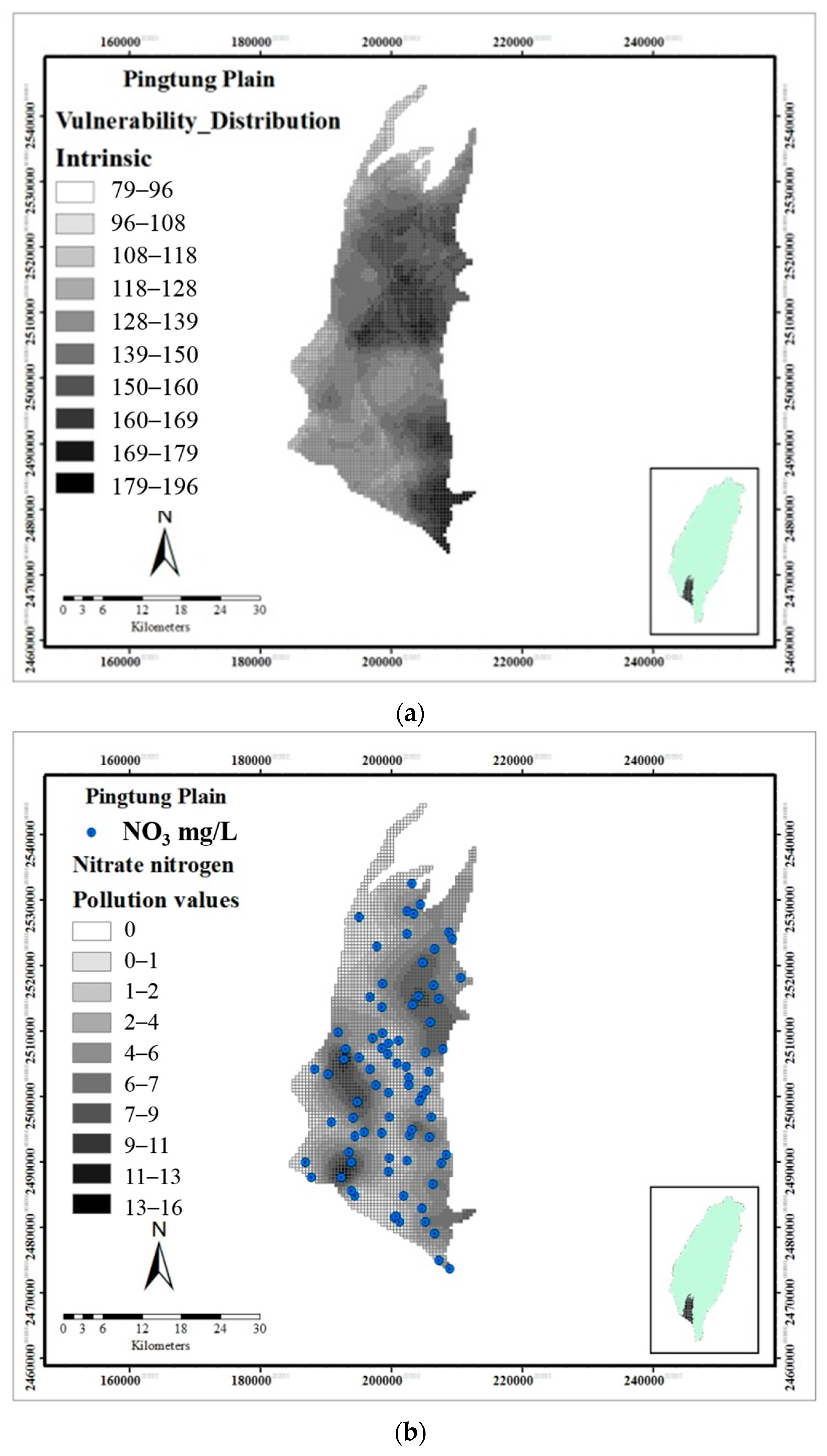
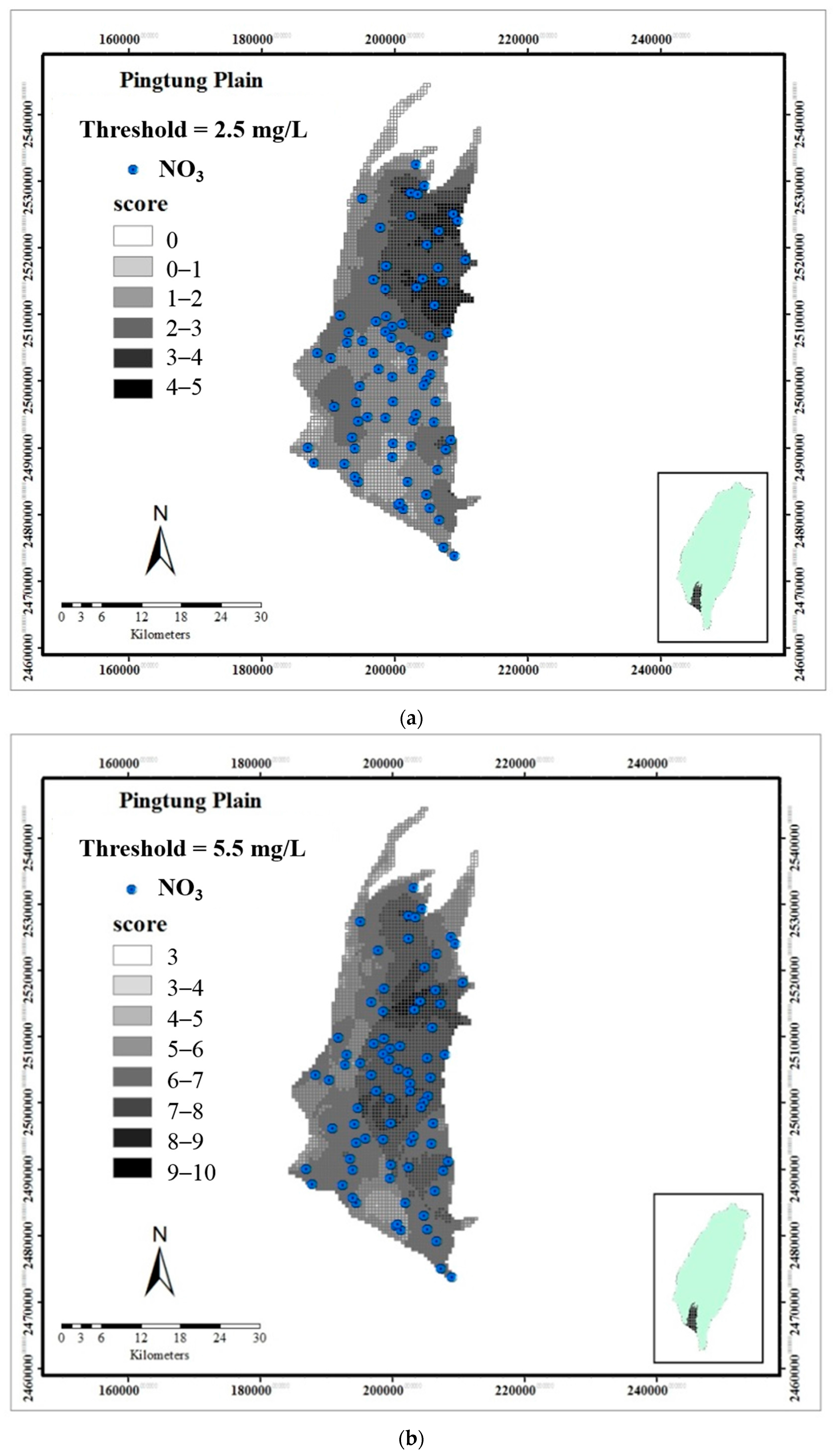
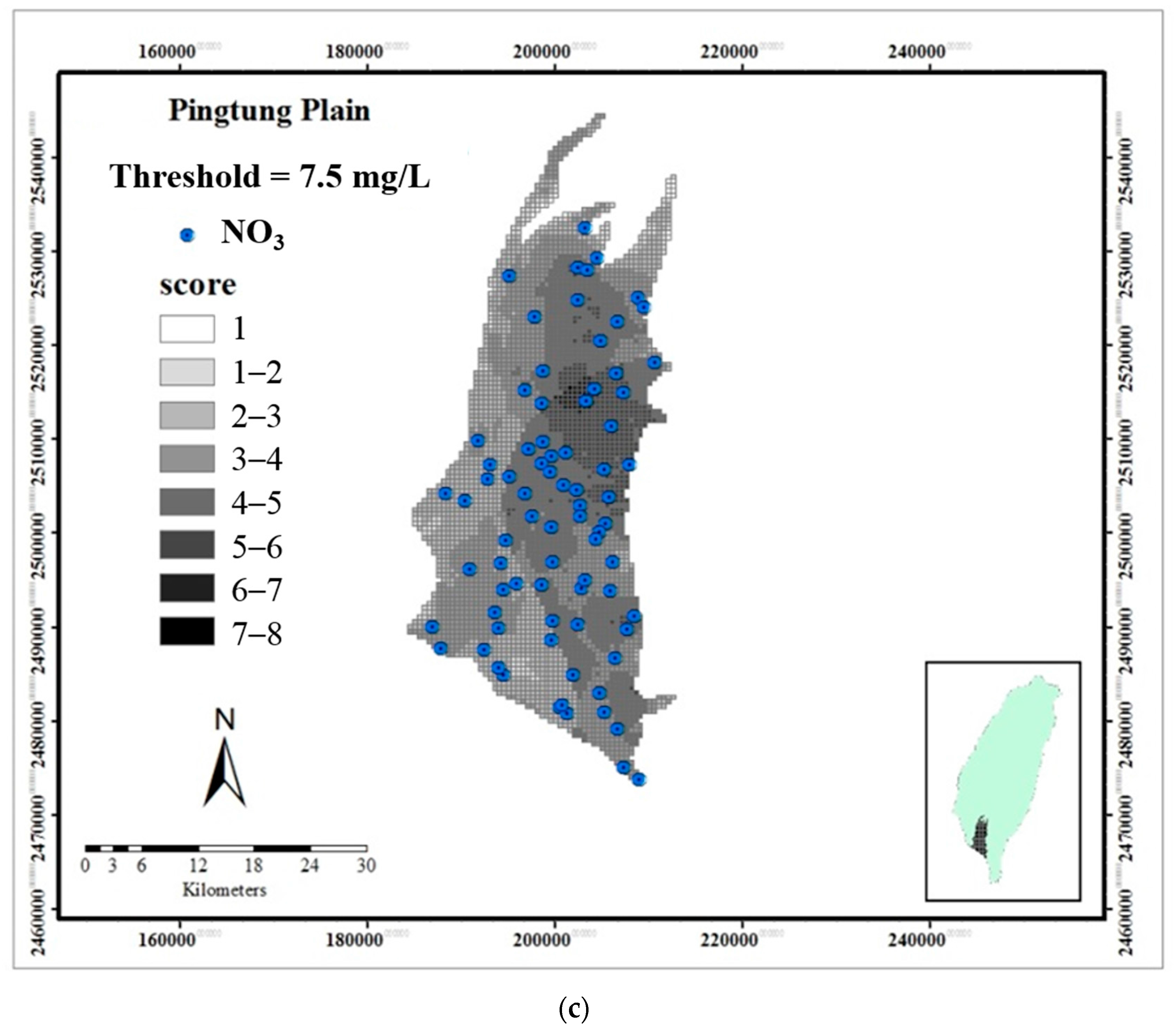
| Land Use Types | Recharge Ratio |
|---|---|
| Developed area | |
| Road/building roof | 0.10 |
| Park/lawn | 0.55 |
| Undeveloped | |
| Cultivated land | 0.60 |
| Pasture/range | 0.65 |
| Forest/woodlands | 0.70 |
| D(m) a | R(cm) a | A b | S b | T a | I b | C(Cmd/m2) a | |
|---|---|---|---|---|---|---|---|
| Weights | 5 | 4 | 3 | 2 | 1 | 5 | 3 |
| Ratings | |||||||
| 10 | 0–1.5 | - | vcG, cG, mG, fG | vcG, cG, mG, fG | 0–2 | vcG, cG, mG, fG | 81> |
| 9 | 1.6–4.5 | >26 | vcS | vcS | 3–6 | vcS | - |
| 8 | - | 18–25 | - | - | - | - | 41–80 |
| 7 | 4.6–9.0 | - | cS | cS | - | cS | - |
| 6 | - | 11–17 | - | - | - | - | 29–40 |
| 5 | 9.1–15 | - | mS | mS | 7–12 | mS | - |
| 4 | - | - | fS | fS | - | fS | 13–28 |
| 3 | 16–22.5 | 6~10 | vfS | vfS | 13–18 | vfS | - |
| 2 | 22.6–30 | - | Z | Z | - | Z | 4–12 |
| 1 | 31+ | 0–5 | M, C | M, C | 19+ | M, C | <4 |
| Thresholds (mg/L) | Total Correct Classification Ratios (%) | Correct Classification Ratios of Polluted Groups (%) | Correct Classification Ratios of Unpolluted Groups (%) | AUC |
|---|---|---|---|---|
| Intrinsic DRASTIC model | ||||
| 2.5 | 64 | 62 | 66 | 0.71 |
| 5.5 | 60 | 62 | 60 | 0.63 |
| 7.5 | 64 | 86 | 61 | 0.76 |
| Modified DRASTIC model | ||||
| 2.5 | 74 | 63 | 83 | 0.84 |
| 5.5 | 75 | 69 | 78 | 0.80 |
| 7.5 | 79 | 86 | 78 | 0.84 |
| Group Types (2.5 mg/L) | −0.17D | 0.02R | 0.32A | −0.11S | 0.13T | 0.10I | 0.14C |
| Polluted | −0.98 | 0.08 | 2.51 | −0.59 | 1.29 | 0.78 | 1.39 |
| Unpolluted | −1.31 | 0.08 | 1.09 | −0.51 | 1.26 | 0.43 | 1.26 |
| Difference | 0.331 | 0.002 | 1.426 | 0.082 | 0.030 | 0.348 | 0.130 |
| Group types (5.5 mg/L) | 0.01D | 0.55R | 0.18A | −0.32S | 0.42T | 0.12I | 0.12C |
| Polluted | 0.07 | 2.66 | 1.22 | −1.49 | 4.18 | 0.88 | 1.15 |
| Unpolluted | 0.07 | 1.84 | 0.76 | −1.60 | 4.06 | 0.56 | 1.10 |
| Difference | 0.006 | 0.820 | 0.464 | 0.107 | 0.121 | 0.318 | 0.043 |
| Group types (7.5 mg/L) | 0.08D | 0.52R | 0.32A | −0.19S | 0.36T | 0.12I | −0.31C |
| Polluted | 0.50 | 2.54 | 2.32 | −0.97 | 3.58 | 0.95 | −2.95 |
| Unpolluted | 0.58 | 1.77 | 1.32 | −0.91 | 3.48 | 0.55 | −2.87 |
| Difference | 0.082 | 0.764 | 0.997 | 0.065 | 0.094 | 0.404 | 0.080 |
© 2016 by the authors; licensee MDPI, Basel, Switzerland. This article is an open access article distributed under the terms and conditions of the Creative Commons Attribution (CC-BY) license (http://creativecommons.org/licenses/by/4.0/).
Share and Cite
Liang, C.-P.; Jang, C.-S.; Liang, C.-W.; Chen, J.-S. Groundwater Vulnerability Assessment of the Pingtung Plain in Southern Taiwan. Int. J. Environ. Res. Public Health 2016, 13, 1167. https://doi.org/10.3390/ijerph13111167
Liang C-P, Jang C-S, Liang C-W, Chen J-S. Groundwater Vulnerability Assessment of the Pingtung Plain in Southern Taiwan. International Journal of Environmental Research and Public Health. 2016; 13(11):1167. https://doi.org/10.3390/ijerph13111167
Chicago/Turabian StyleLiang, Ching-Ping, Cheng-Shin Jang, Cheng-Wei Liang, and Jui-Sheng Chen. 2016. "Groundwater Vulnerability Assessment of the Pingtung Plain in Southern Taiwan" International Journal of Environmental Research and Public Health 13, no. 11: 1167. https://doi.org/10.3390/ijerph13111167
APA StyleLiang, C.-P., Jang, C.-S., Liang, C.-W., & Chen, J.-S. (2016). Groundwater Vulnerability Assessment of the Pingtung Plain in Southern Taiwan. International Journal of Environmental Research and Public Health, 13(11), 1167. https://doi.org/10.3390/ijerph13111167





